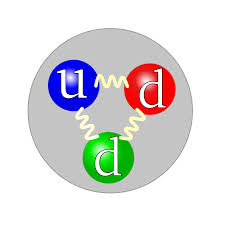记忆方法
为了记住“neutron”,你可以采用以下简单记忆法:
联想到“neutron”的“n”和“tron”部分。想象它像一个“n”形的粒子(即中子),它由一个“n”和一个“tron”(“tron”在古英语中有“轮子”的意思,这里可以想象为中子旋转着在原子核中滚动)。这个形象可以帮助你记住“neutron”是一个在原子核中不携带电荷的基本粒子。
联想到“neutron”的“n”和“tron”部分。想象它像一个“n”形的粒子(即中子),它由一个“n”和一个“tron”(“tron”在古英语中有“轮子”的意思,这里可以想象为中子旋转着在原子核中滚动)。这个形象可以帮助你记住“neutron”是一个在原子核中不携带电荷的基本粒子。
以上内容由AI生成, 仅供参考和借鉴
中文词源
neutron 中子
来自neutral,中性的,-on,物理名词后缀,来自eon.
英语词源
- neutron (n.)
- "electrically neuter particle of the atom," 1921, coined by U.S. chemist William D. Harkins (1873-1951) from neutral (adj.) + -on. First record of neutron bomb is from 1960. Neutron star attested from 1934, originally hypothetical; so called because it would be composed of neutrons.
权威例句
- 1. A neutron star has a gravitational field strong enough to generate X-rays.
- 中子星上存在强大的重力场,足以产生X射线。
- 2. A neutron is simply a neutral particle in the nucleus of an atom.
- 中子就是原子核里不带电的粒子。
- 3. The dark star in Nova Muscae 1991 is a black hole rather than a neutron star.
- 在1991年苍蝇座中的暗星其实是一个黑洞而非中子星。
- 4. Neutron stars are the second exhibit in the gallery of stellar corpses.
- 中子星是死之恒星陈列馆内第二类样品.
- 5. A neutron has no appreciable electromagnetic interaction with nuclei or with electrons.
- 中子与原子核或与电子并没有可察觉的电磁相互作用.

